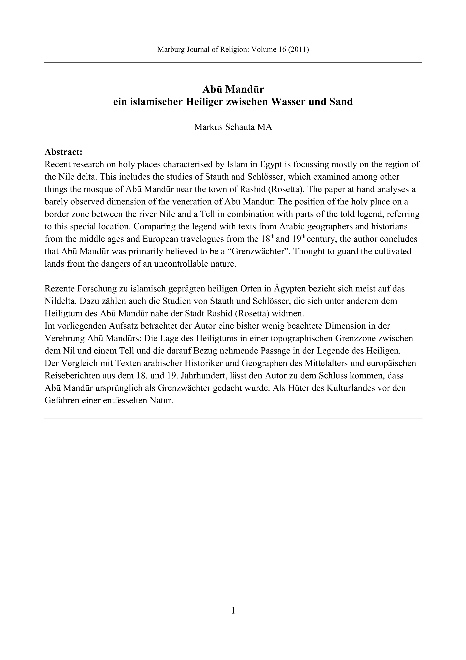Abū Mandūr. Ein islamischer Heiliger zwischen Wasser und Sand
Recent research on holy places characterised by Islam in Egypt is focussing mostly on the region of the Nile delta. This includes the studies of Stauth and Schlosser, which examined among other things the mosque of Abū Mandūr near the town of Rashid (Rosetta). The paper at hand analyses a barely obs...
Gespeichert in:
| Veröffentlicht in: | Marburg Journal of Religion |
|---|---|
| 1. Verfasser: | |
| Format: | Artikel (Zeitschrift) |
| Sprache: | Deutsch |
| Veröffentlicht: |
Philipps-Universität Marburg
2011
|
| Schlagworte: | |
| Online Zugang: | Online Zugang |
| Tags: |
Tag hinzufügen
Keine Tags, Fügen Sie den ersten Tag hinzu!
|
| Zusammenfassung: | Recent research on holy places characterised by Islam in Egypt is focussing mostly on the region of the Nile delta. This includes the studies of Stauth and Schlosser, which examined among other things the mosque of Abū Mandūr near the town of Rashid (Rosetta). The paper at hand analyses a barely observed dimension of the veneration of Abū Mandūr: The position of the holy place on a border zone between the river Nile and a Tell in combination with parts of the told legend, referring to this special location. Comparing the legend with texts from Arabic geographers and historians from the middle ages and European travelogues from the 18 th and 19th century, the author concludes that Abū Mandūr was primarily believed to be a “Grenzwachter”. Thought to guard the cultivated lands from the dangers of an uncontrollable nature.Rezente Forschung zu islamisch gepragten heiligen Orten in Agypten bezieht sich meist auf das Nildelta. Dazu zahlen auch die Studien von Stauth und Schlosser, die sich unter anderem dem Heiligtum des AbūMandū nahe der Stadt Rashid (Rosetta) widmen. Im vorliegenden Aufsatz betrachtet der Autor eine bisher wenig beachtete Dimension in der Verehrung AbūMandūs: Die Lage des Heiligtums in einer topographischen Grenzzone zwischen dem Nil und einem Tell und die darauf Bezug nehmende Passage in der Legende des Heiligen. Der Vergleich mit Texten arabischer Historiker und Geographen des Mittelalters und europaischen Reiseberichten aus dem 18. und 19. Jahrhundert, lasst den Autor zu dem Schluss kommen, dass AbūMandū ursprunglich als Grenzwachter gedacht wurde. Als Huter des Kulturlandes vor den Gefahren einer entfesselten Natur. |
|---|---|
| DOI: | 10.17192/mjr.2011.16.3287 |
 Publikationsserver
Publikationsserver